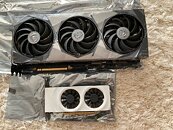
Kingston Announces the FURY Renegade DDR5 Memory Series
Kingston FURY, the gaming division of Kingston Technology Company, Inc., a world leader in memory products and technology solutions, announced today the release of Kingston FURY Renegade DDR5 and Kingston FURY Renegade DDR5 RGB memory. The Kingston FURY Renegade DDR5 family is engineered to maximize the performance of your system.
Kingston FURY Renegade DDR5 family pushes the performance of next-gen DDR5 platforms to the extreme with ultra-fast memory up to 6400MT/s1and quick CL32 timings. With premium components hand-tuned by engineers, rigorously tested for compatibility across the industry's leading motherboards, backed by 100% factory testing at speed, and Intel XMP 3.0 Certified, customers can enjoy the ultimate overclock experience.
Kingston FURY Renegade DDR5 family pushes the performance of next-gen DDR5 platforms to the extreme with ultra-fast memory up to 6400MT/s1and quick CL32 timings. With premium components hand-tuned by engineers, rigorously tested for compatibility across the industry's leading motherboards, backed by 100% factory testing at speed, and Intel XMP 3.0 Certified, customers can enjoy the ultimate overclock experience.



























































